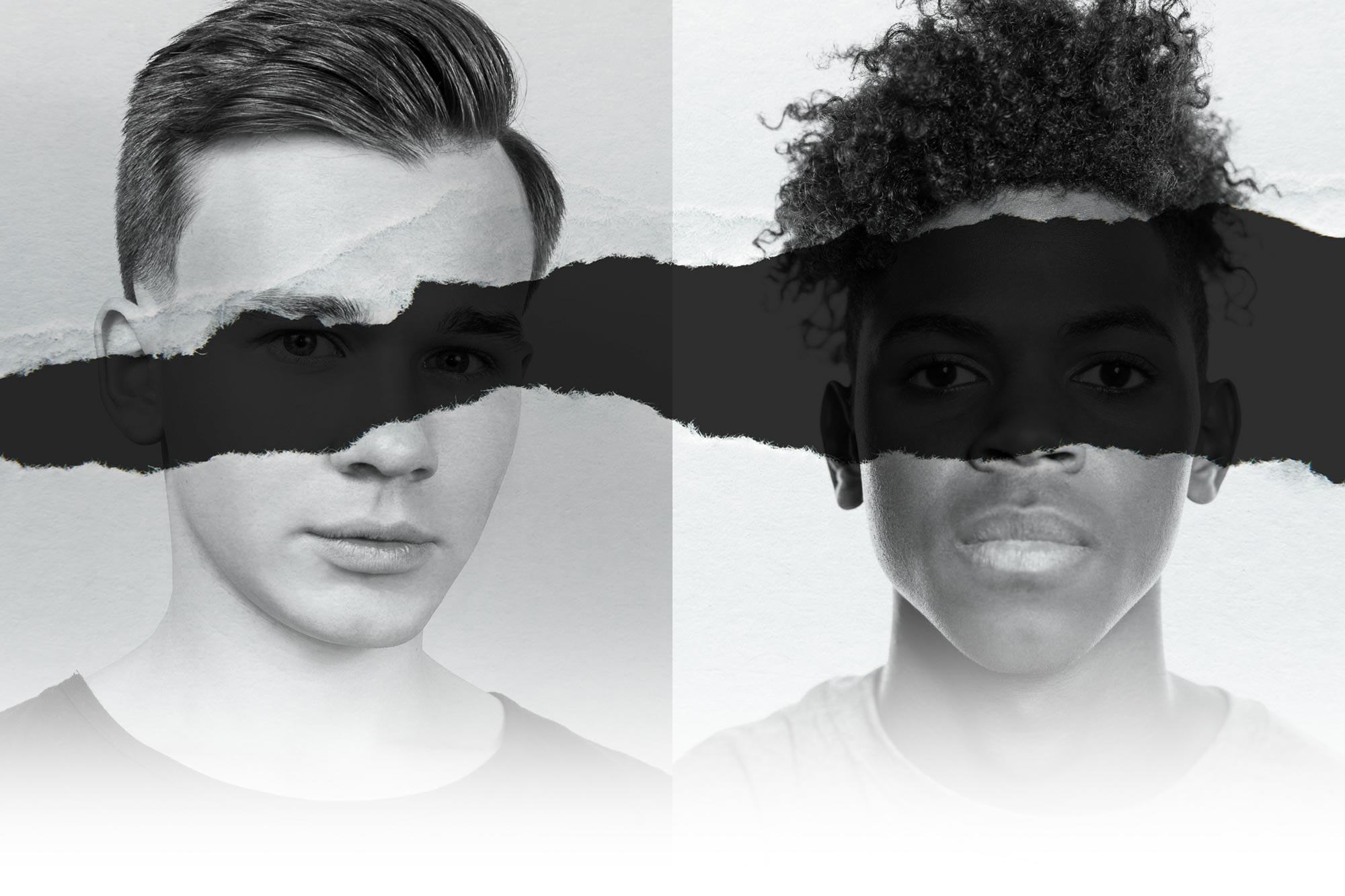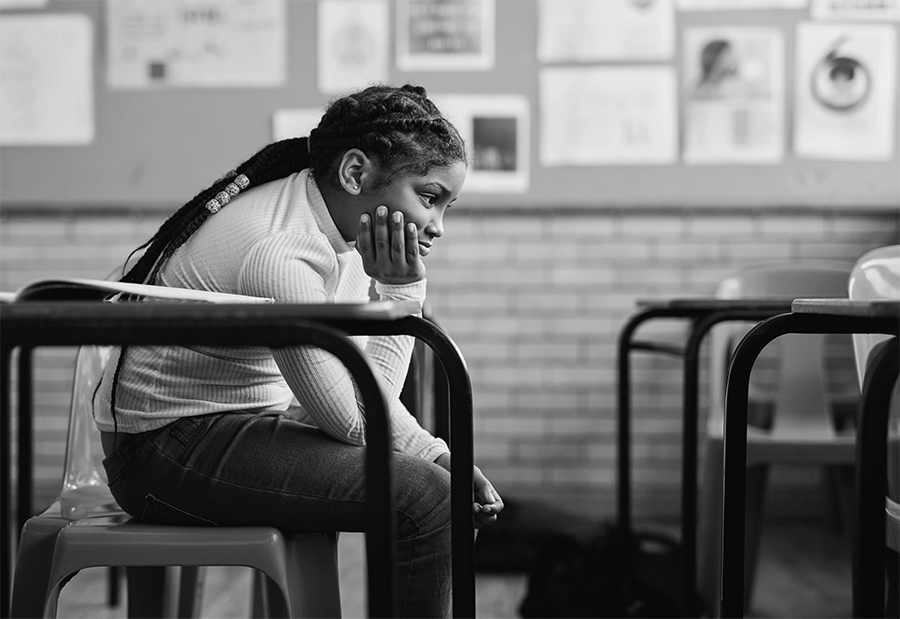
who attend the same middle school act out in similar ways — they were texting or doodling in class instead of taking notes, despite repeated warnings — and both are sent to the principal’s office. One child’s parents are called and a meeting is scheduled to discuss how his misbehaviors can be better addressed, or if there is something happening at home that is affecting his behavior in school. The second student’s parents receive a very different phone call — a parent or guardian needs to pick the boy up now, and he is being suspended for two days. This is his second suspension of the year for minor infractions.
who attend the same middle school act out in similar ways — they were texting or doodling in class instead of taking notes, despite repeated warnings — and both are sent to the principal’s office. One child’s parents are called and a meeting is scheduled to discuss how his misbehaviors can be better addressed, or if there is something happening at home that is affecting his behavior in school. The second student’s parents receive a very different phone call — a parent or guardian needs to pick the boy up now, and he is being suspended for two days. This is his second suspension of the year for minor infractions.







who attend the same middle school act out in similar ways — they were texting or doodling in class instead of taking notes, despite repeated warnings — and both are sent to the principal’s office. One child’s parents are called and a meeting is scheduled to discuss how his misbehaviors can be better addressed, or if there is something happening at home that is affecting his behavior in school. The second student’s parents receive a very different phone call — a parent or guardian needs to pick the boy up now, and he is being suspended for two days. This is his second suspension of the year for minor infractions.
who attend the same middle school act out in similar ways — they were texting or doodling in class instead of taking notes, despite repeated warnings — and both are sent to the principal’s office. One child’s parents are called and a meeting is scheduled to discuss how his misbehaviors can be better addressed, or if there is something happening at home that is affecting his behavior in school. The second student’s parents receive a very different phone call — a parent or guardian needs to pick the boy up now, and he is being suspended for two days. This is his second suspension of the year for minor infractions.

 this example, the only evident difference between the two students is their race. Nearly 10 years ago, the U.S. Department of Education reported that African American students across the country were 31 percent more likely to be disciplined for the same discretionary violation as white students. In 2018, upon finding highly disparate discipline rates based on race continued to exist, the U.S. Government Accounting Office reported that “implicit bias on the part of teachers and staff may cause them to judge students’ behaviors differently based on the students’ race and sex.”
this example, the only evident difference between the two students is their race. Nearly 10 years ago, the U.S. Department of Education reported that African American students across the country were 31 percent more likely to be disciplined for the same discretionary violation as white students. In 2018, upon finding highly disparate discipline rates based on race continued to exist, the U.S. Government Accounting Office reported that “implicit bias on the part of teachers and staff may cause them to judge students’ behaviors differently based on the students’ race and sex.”
These findings reflect the reality in California public schools as well. While African American students account for less than 6 percent of the state’s public school enrollment, they account for 17.8 percent of students who are suspended and 14.1 percent of those who are expelled, according to a 2018 study by researchers at the University of California, Los Angeles and San Diego State University.
Tyrone Howard, director of the Black Male Institute at UCLA and co-author of the report Get Out: Black Male Suspensions in California Public Schools, said that students can experience the same campus in vastly different ways due to racial biases and punitive disciplinary policies. In the scenario of the two boys, for instance, it is painfully easy to guess which of the students is likely black.
“Kids are currently not able to experience school the same way because of disproportionality, and that’s a real violation of what we say we provide for all children,” Howard said. “In lots of ways, this is a civil rights issue because it gets to issues of fairness and of justice, and a public education is supposed to be that proverbial equalizer that helps to create opportunity for those who are in the margins.”
Justices on the California Fifth District Court of Appeals signaled their agreement in August 2019 when they revived equal-protection claims against state education officials brought by current and former students of the Kern High School District over rationally discriminatory disciplinary practices that resulted in a disparate impact for black and Latino students. In Collins v. Thurmond (2019), the court said, “it is reasonable to conclude that students of a district subject to de facto racial segregation due to racially discriminatory disciplinary practices are receiving an education that is fundamentally below the standards provided elsewhere throughout the state where the legal proscriptions on such discriminatory practices are being enforced.”

Such findings don’t surprise Howard, whose report showed other parts of the San Joaquin Valley struggling with disproportionality. Researchers found that the highest suspension rates for black males occurred in rural counties, while the highest total suspensions were reported in large urban areas including Los Angeles, Sacramento, San Bernardino, Riverside and Contra Costa counties. Those five counties alone accounted for 61 percent of black male suspensions during the 2016–17 school year.
Being suspended early and more often can have negative long-term implications. As early as sixth grade, poor school attendance, including due to out-of-school suspensions, has been identified as an indicator that a student will later drop out of high school.
Director of UCLA’s Center for Civil Rights Remedies Daniel Losen said he has seen how students with disabilities can be disproportionately impacted by punitive disciplinary practices, and how the confluence of race and disability status further disadvantages children.
“We see that black kids with disabilities aren’t being suspended more often for serious offenses, but minor offenses like disruption or defiance,” Losen said. “That raises a huge red flag for students with disabilities that it doesn’t raise of any other group, because unlike other kids, students with disabilities have a legal right not to be removed from class because of behaviors caused by their disability, with the exception that some kids need a more restrictive placement as outlined in their individualized education program.”
That means a student diagnosed with attention deficit hyperactivity disorder who often interrupts or gets up from their desk when they’re not supposed to should not be removed from the classroom for exhibiting such behaviors. But that doesn’t mean it doesn’t happen, Losen said.
Under federal law, a child cannot be suspended for more than 10 consecutive school days or expelled from school for misconduct that is caused by their disability. After 10 days of suspension, districts must hold manifestation determination meetings with a child’s IEP team to conduct a behavioral assessment for the student, modify an existing behavior plan to address the issue or move to place the child in a different, possibly more restricted learning environment.
“These procedural protections don’t seem to be doing the job, and at the end of the day, it’s about the teachers and administrators understanding this,” Losen said. “Most people would agree in conversation that, of course, we shouldn’t be suspending a kid because of behavior they can’t control. That isn’t fair. But it happens all the time.”
Part of the problem with suspending students for disability-related behaviors prior to reassessing if they need additional or different support services is that children with disabilities receive more specialized services than their peers when they are in school — whether it be occupational therapy, physical therapy, counseling or specialized instruction.
“It’s a much bigger denial of educational opportunity, because they’re getting so much more when they’re in school that they need to be successful,” Losen said. “It’s also harder for them to catch back up. These kids often come back to school worse for the experience.”
Losen, a former teacher, said he understands the complexities of heading a classroom where one student’s misbehavior can create a ripple effect among other kids. In fact, he admitted that he was the teacher who, in his first year, often sent children to the principal’s office for misbehaving. The problem had less to do with his second-graders, and more to do with his lack of classroom management skills.
Once he received training in de-escalation techniques and positive behavioral interventions, student misbehaviors rarely spiraled out of control, he said.

Then, Gov. Gavin Newsom signed a bill in September 2019 expanding the ban on out-of-school suspensions for willful defiance in California to cover students through fifth grade beginning July 1, 2020. The bill also expands the ban to grades 6 through 8 from July 1, 2020 through July 1, 2025.
Losen said such bans are especially important for children who have experienced trauma and may be acting out as a cry for help. It makes sense to adopt constructive interventions for minor behaviors rather than relying on suspensions, he said.
Throughout California, districts and schools have begun hiring additional mental health specialists and adopting restorative justice practices, including conflict resolution and peer-mediated small groups, to better deal with student misbehavior.
Although some schools have seen success with these techniques, others, including the Los Angeles Unified School District, which banned suspensions for willful defiance across all grade levels in 2013, have struggled. Teachers are reporting insufficient training in restorative justice techniques that are meant to replace the use of the now-barred suspensions.
Howard of UCLA said that without proper professional development, the transition from relying on suspensions to using restorative justice practices will only leave teachers frustrated. It is also important that districts ensure training includes methods of understanding, and identifying and responding to trauma that students face outside of school, as well as how to tackle unconscious bias.
Unconscious biases are learned stereotypes that are frequently deeply ingrained and able to influence behavior without one realizing it. Studies have shown that everyone holds unconscious beliefs about various social, racial and identity groups, which can even be incompatible with one’s own values.

According to the district’s 2019–20 Local Control and Accountability Plan, those rates have continued to drop. The district’s updated goal is to further reduce overall suspensions by at least 1 percent from the previous school year and reduce suspensions of African American and English learner students by at least 1 or 2 percent.
Reaching this point was not “a walk in the park with rainbows and unicorns,” said Jon Hill, vice president of the Monterey Peninsula Unified school board. First, there had to be frank and honest discussions among board members about how to reckon with their own unconscious biases and the systemic disadvantages that some students face in school.
“Any board that wants to address this needs to understand there will be tough conversations,” Hill said. “Our board has been challenged to think and rethink ideas about school resource officers, drug-sniffing dogs and other factors that are at least on the periphery of student behavior. There are also tensions within our community over police and crime, and all of those factors outside of the schools mean we have to address some tender spots and have tough conversations that aren’t a lot of fun but are so important.”
Though he said board members haven’t always agreed with one another on these topics, their unwavering commitment to equity and providing opportunities to thrive for every child in Monterey Peninsula has kept things moving forward.
Since becoming aware of the district’s significant disparities in suspensions among student groups, the board and Superintendent PK Diffenbaugh have made social-emotional learning a major component in each school. Monterey Peninsula is also a positive behavioral interventions and supports, or PBIS, district.
PBIS is an approach schools use to improve safety and promote positive behavior. It also helps teachers and administrators decide how to respond to a child who misbehaves across a scale of three tiers of support for both students and school staff that focus less on punishment and more on teaching expectations and preventing problems from occurring in the first place.
None of this works, however, without the proper training.
“One issue I’ve seen is that if you take away the tool of suspension and don’t replace it with anything, then discipline in your schools falls apart,” Hill said. “You have to build in training and resources for teachers, principals and counselors so that they have viable options if you’re going to be mindful about the use of suspension and why you use it, and when to rely on other measures.”
Schools boards must be methodical about how to balance training district staff while limiting disruptions to student learning, Hill said.
A key strategy in Monterey Peninsula USD’s efforts to lower overall suspension rates as well as disproportionality is making the issue a priority in the LCAP process — something UCLA’s Howard said he would like to see more of throughout the state.
Since the release of the 2018 report on disproportionate discipline, Howard said he has been approached by districts with data showing a reduction in overall suspensions, yet few are closing gaps in rates between student groups. In some districts, Howard found disproportionality had actually worsened.
Some of that he chalks up to a lack of training in practices outside of doling out suspension referrals. When it comes to restorative justice, for instance, he said many teachers are not really buying in because they are at their wit’s end, and they’ve not been taught how to deal with student misbehaviors without the use of suspensions.
In addition to improved training, Howard said it’s important that districts look to teachers who work with students across the academic, behavioral and ability spectrum and who rarely, if ever, send kids to the principal’s office for minor misbehaviors.
“We need to find out what those teachers are doing,” he said. “A lot of the time it comes down to relationship building and knowledge and understanding of social-emotional needs that students have. If we can start to build that into what our teachers know and do and understand, I think we’ll be in a much better place.”
Alisha Kirby is a staff writer for California Schools.